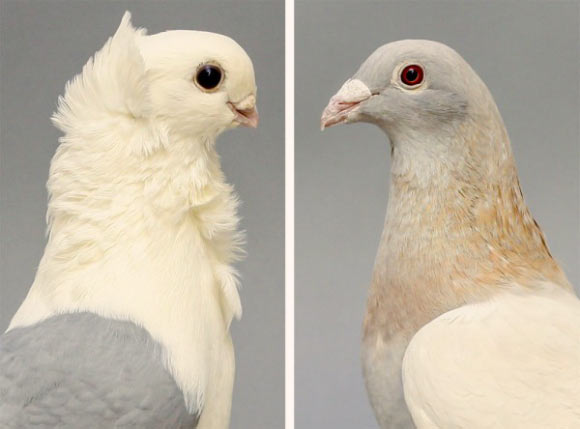Charles Darwin bred domestic pigeons (Columba livia), and in his Origin of Species described the numerous variations that had been selected by pigeon fanciers. He thought these birds held the secrets of selection in their beaks. Free from the bonds of natural selection, over 350 breeds have beaks of all shapes and sizes within a single species. The most striking are beaks so short that they sometimes prevent parents from feeding their own young. In a new study, biologists discovered that a mutation in the ROR2 gene is linked to beak size reduction domestic pigeons; surprisingly, mutations in this gene also underlie a human disorder called Robinow syndrome.

Old German Owl (left) and Racing Homer (right) domestic pigeon breeds that were bred by Boer et al.. Image credit: Sydney Stringham.
“Some of the most striking characteristics of Robinow syndrome are the facial features, which include a broad, prominent forehead and a short, wide nose and mouth, and are reminiscent of the short-beak phenotype in pigeons,” said Dr. Elena Boer, a postdoctoral researcher at the University of Utah.
“It makes sense from a developmental standpoint, because we know that the ROR2 signaling pathway plays an important role in vertebrate craniofacial development.”
For the study, Dr. Boer and colleagues bred two pigeons with short and medium beaks: (i) the medium-beaked male was a Racing Homer, a bird bred for speed with a beak length similar to the ancestral rock pigeon; (ii) the small-beaked female was an Old German Owl, a fancy pigeon breed that has a little, squat beak.
“Breeders selected this beak purely for aesthetics to the point that it’s detrimental — it would never appear in nature,” said University of Utah’s Professor Michael Shapiro.
“So, domestic pigeons are a huge advantage for finding genes responsible for size differences.”
“One of Darwin’s big arguments was that natural selection and artificial selection are variations of the same process. Pigeon beak sizes were instrumental in figuring out how that works.”
The short- and medium-beaked parents produced an initial F1 brood of children with intermediate-length beaks.
When the researchers mated the F1 birds to one another, the resulting F2 grandchildren had beaks ranging from big to little, and all sizes in between
To quantify the variation, they measured beak size and shape in the 145 F2 individuals using micro-CT scans.
“The cool thing about this method is that it allows us to look at size and shape of the entire skull, and it turns out that it’s not just beak length that differs — the braincase changes shape at the same time,” Dr. Boer said.
“These analyses demonstrated that beak variation within the F2 population was due to actual differences in beak length and not variation in overall skull or body size.”
Using a technique called quantitative trait loci (QTL) mapping, the scientists identified DNA sequence variants scattered throughout the pigeons’ genomes.
They then looked to see if those mutations appeared in the F2 grandkids’ chromosomes.
“The grandkids with small beaks had the same piece of chromosome as their grandparent with the small beak, which told us that piece of chromosome has something to do with small beaks,” Professor Shapiro said.
“And it was on the sex chromosome, which classical genetic experiments had suggested, so we got excited.”
The authors then compared the entire genome sequences of many different pigeon breeds: 56 pigeons from 31 short-beaked breeds and 121 pigeons from 58 medium- or long-beaked breeds.
They found that all individuals with small beaks had the same DNA sequence in an area of the genome that contains the ROR2 gene.
“The fact that we got the same strong signal from two independent approaches was really exciting and provided an additional level of evidence that the ROR2 locus is involved,” Dr. Boer said.
A paper on the findings was published today in the journal Current Biology.
_____
Elena Boer et al. Current Biology, published online September 21, 2021;







